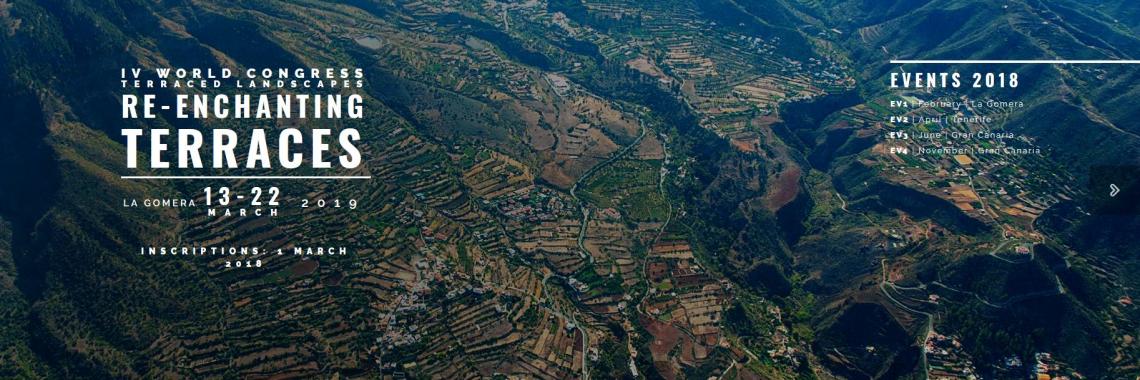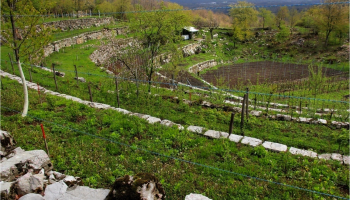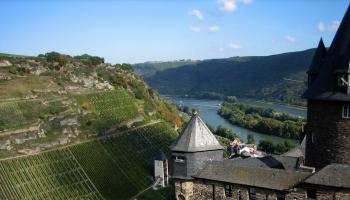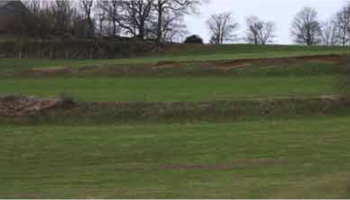Terasované krajiny
(1) Táto forma využívania pôdy je stvárnená v terasách, aby sa maximalizovalo oslnenie. Terasy sú typické pre celé Stredomorie. Typické rastliny sú: hrozno na víno, olivové a ovocné stromy.
(2) Kultúrne terasy sú zvyčajne veľmi ťažko datovateľné. Veľmi málo z nich je známych z doby bronzovej a viac archeologických dôkazov pochádza z obdobia klasického Grécka. Ako sa časom rozšírili je stále veľmi neisté. Zdroj: (1) Definícia bola vypracovaná v rámci Eucaland-Project na účely tohto projektu. (2) Grove a Rackham 2001.
Poľnohospodárske krajiny na terasách pozostávajú z pastvín ako aj v polí. Je to krajina vytvorená človekom pre výrobu vína a pestovanie ovocia. Nezahŕňa umelé terasy z baníctva alebo skládky odpadu, zavlažované lúky v kopcovitých oblastiach, ktoré majú terasovitý vzhľad, Wölbäcker / Bifang [DE] (vyvýšený záhon / pole, hlavne v zamokrených oblastiach), infraštruktúrne
terasy (napr. cesty, hrádze, terasy pre výstavbu rodinných domov), mikro-terasy vzniknuté po presunoch domácich a / alebo divokých zvierat.
Zdroj: Definícia bola vypracovaná v rámci Eucaland-Project na účely tohto projektu.
Database entries forTerasované krajiny
Research: Goran Andlar, Filip Šrajer et al.; upload: Bénédicte Gaillard. The entries are still in process
Research: Alexandra Kruse & Bénédicte Gaillard; Upload: Bénédicte Gaillard. The entries are still in process
Artificial terraced landscape date back early and historical findings prove wine cultivation at the rivers through Romans. They already used prepared terraces for the cultivation.
The majority of terraces is used for fruit, olive and wine production in the southern parts of… [Read more]
Research & Upload: Alexandra Kruse. The entries are still in process
The used name in Germany is Terrassen and for the landscape Terrassenlandschaft, according to their function also Ackerterrassen and especially important Weinterrassen for wine growing. Old names are Stufenrain, Kulturwechselstufen (see fig. 2). An additional historic type is the so called “Wölbäcker”(see fig. 3). There is a huge agrarmorphological ensemble of relief… [Read more]
Research: Hans Renes; Upload: Bénédicte Gaillard. The entries are still in process
Research: NIBIO, Sebastian Eiter, Oskar Puschmann et al; upload: Bénédicte Gaillard. The entries are still in process, the e-atlas is still under development
Terraces have been a very common feature in parts of the Norwegian agricultural landscape for centuries. The general Norwegian term for terrace is … [Read more]
Research: Martina Slámová, Jana Špulerová, Marta Dobrovodská, Dagmar Štefunková; upload: Bénédicte Gaillard.
Terraces for agricultural land use were established primarily during the Walachian colonisation wave between the 14th and 16th centuries in Slovakia (Stankoviansky, 2003… [Read more]
Research: Drago Kladnik et al. Anton Melik Geographical Institute ZRC SAZU & Slovenian Academy of Sciences and Arts; upload: Bénédicte Gaillard. The entries are still in process
Research: Padoc Research Group Universidad Politécnica de Madrid; upload: Bénédicte Gaillard. The entries are still in process
Research: Della Hooke; upload: Bénédicte Gaillard. The entries are still in process.
Deliberately created cultivation terraces have never been a feature in England (or the UK) but lynchets… [Read more]

















